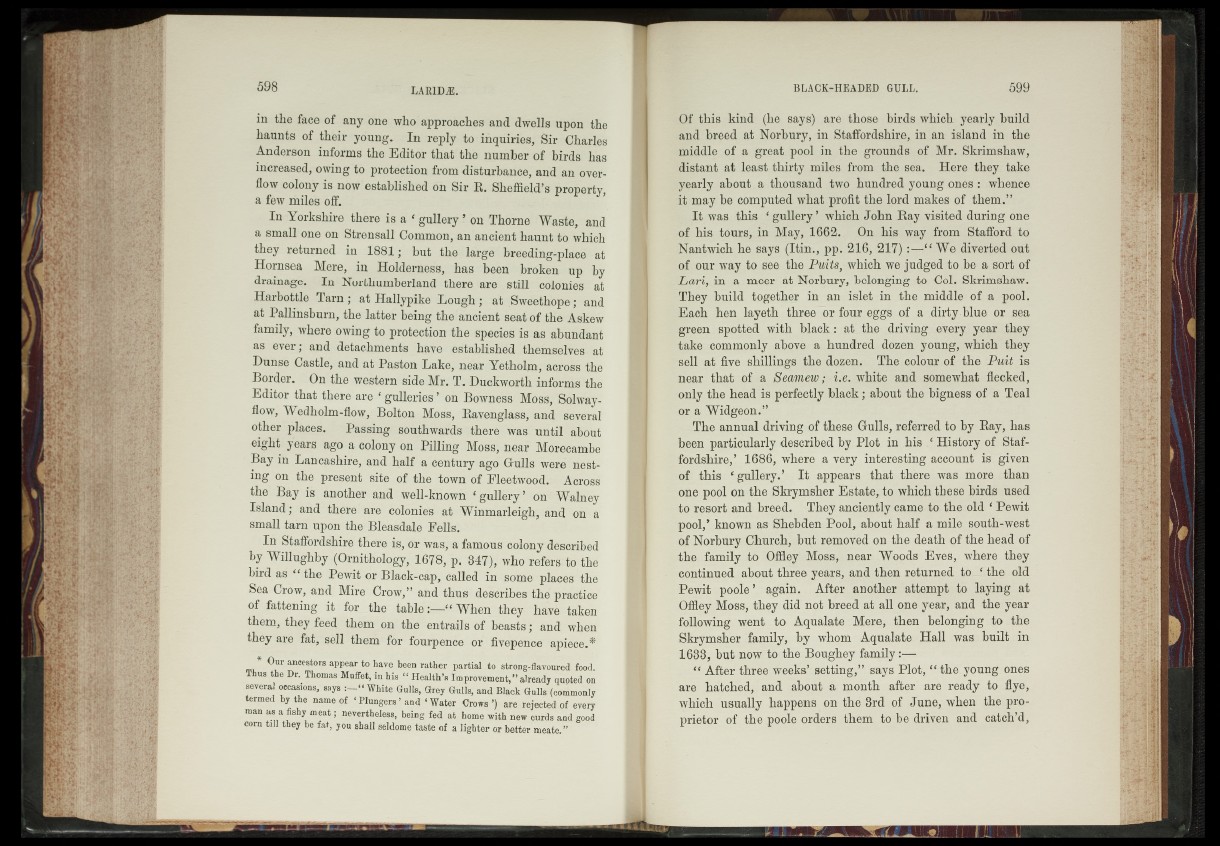
in the face of any one who approaches and dwells upon the
haunts of their young. In reply to inquiries, Sir Charles
Anderson informs the Editor that the number of birds has
increased, owing to protection from disturbance, and an overflow
colony is now established oh Sir R. Sheffield’s property
a few miles off.
In Yorkshire there is a f gullery.’ on Thorne Waste, and
a small one on Strensall Common, an ancient haunt to which
they returned in 1881; but the large breeding-place at
Hornsea Mere, in Holderness, has been broken up by
drainage. In Northumberland there are still colonies at
Harbottle Tarn; at Hallypike Lough; at Sweethbpe; and
at Pallinsburn, the latter being the ancient seat of the Askew
family, where owing to protection the species is as abundant
as ever; and detachments have established themselves.'at
Dunse Castle, and at Paston Lake, near Yetholjn, across the
Border. On the western side Mr. T. Duckworth inforinsljie
Editor that there are ‘ gulleries I on Bowness Moss, Solway-
flow, Wedholm-flow, Bolton Moss, Ravenglass, and several
other places. Passing southwards there was urit|Ij about
eight years ago a colony on Pilling Moss; neat Morecambe
Bay in Lancashire, and half a eentury ago Gulls were ^nesting
qn. the present site of the town of Fleetwood.- Across
the Bay is another and well-known ‘ gallery -:-on Walney
Island; and there are colonies at Winmarleigh, and oh a
small tarn upon the Bleasdale Fells.
In Staffordshire there is, Or was, a famous colony described
by Willughby (Ornithology,' 1678, p. 847-)/who refers: to the
bird as “ -the Pewit or Black-cap, called fiaKsome places the
Sea Crow, and Mire Crow,” and thus- describes the'pi’ldtice
of fattening it for_the table When they have^tafcen
them, they feed them on' the '-entrails of beasts ;, and when
they are fat, sell them for fourpence or fivepence' apiece.*
* Our ancestors appear to Wp.fifien rather partial to stroDg-flavoured, food.
Thus the Dr. Thomas Mnffet, in his 1 Heath’s Improvement,” already qngfed on
several occasions, says - - - “ White Gull's, Gre/.ftnls, and Black GulIs (c6mmonly
termed by the name of - | Plungers ’ and ‘ Water Crows ’) . are ,r ^ c t e * of. every
man as a fishy meat; nevertheless, tW&g/fpd at home with new curds and good
cam till they be Ut; you shall seldome taste of a lighter or better meat<>
Of this kind (he says) are those birds which yearly build
and breed at Norbury, in Staffordshire, in an island -in the
middle of a great, .pool in the grounds of Mr. Skrimshaw,
distant at least thirty miles from the sea. Here they take
yearly about a thousand two hundred young ones: whence
it may be computed what profit the lord makes of them.”
It was this | gullery ’ which John Ray visited during one
of his tours, in May, 1662. On his way from Stafford to
Nantwich he says (Itinv;ppi;,2J6, 217):—“ We diverted out
,of our way;to see the Puits, which we judged toibe a sort of
I%d/ri, in a meer at Norbury, belonging to Col. Skrimshaw.
They . build together in an islet in the middle of a pool.
Each hen layeth three or four eggs of a .dirty blue or sea
green spotted with black: at the driving every year they
take commonly above a hundred dozen young, which they
sell at five shillings Jhe dozen. The.colour.of the PuUAs
hear that of a Seamew ; i.e. white and somewhat flecked,
only the head is perfectly black ; about the bigness of a Teal
or a Widgeon iE i
The annual driving of those Gulls, referred to by Ray, has
been particularly, described by plot in his ‘ History of Staffordshire,’
1686, where a very interesting account is given
of this ‘ gullery.’ It appears that there, was more than
one pool on the Skrymsher Estate^to which these birds used
to resort and breed. They anciently came to the old ‘ Pewit
pool,’ known as Shebden,BqqJJ about half a mile south-west
of Norbury Church, but removed on the death of the head of
the family to Offley Moss, near Woods Eves, where they
continued. about three years, and then returned to_i.the old
Pewit poole ’ -again., After another attempt to laying at
.Qfliey Moss, they did not breed at all one year, and the year
following went to Aqualate Mere, then belonging :£to .the
Skrymsher family, by whom Aqualate Hall was built in
1688-, but now to the Boughey family
“ After three weeks’-: setting;” says Plot, “ the. young ones
are hatched, and about a month after are ready to flye,
which usually happens on the 3rd of June, when the proprietor
of the jpoole orders them to^be driven and catch’d,